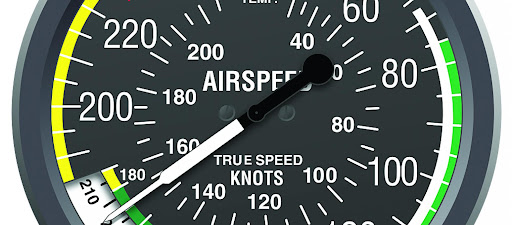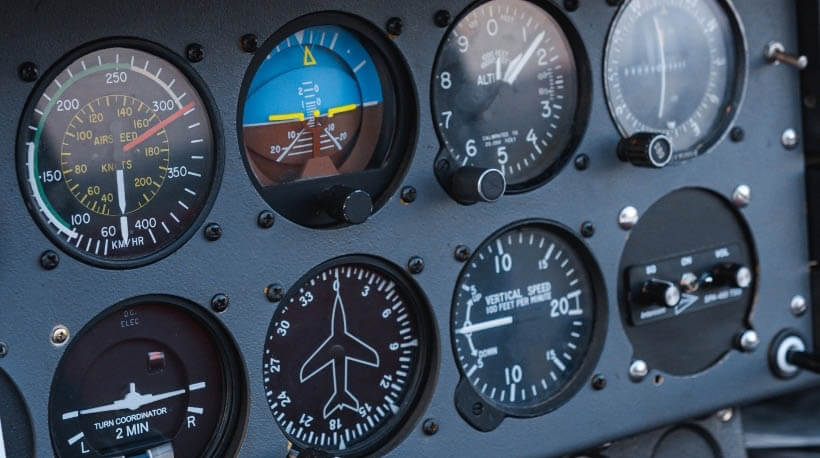
Runway Markings Guide
Discover the importance of understanding runway markings, which guide pilots during takeoffs, landings, and taxiing.
These flight instruments act as a pilot’s guiding tools, delivering essential information needed to navigate the ever-changing skies. From measuring altitude to determining orientation, the six instruments are indispensable resources that pilots depend on throughout every stage of their flight.
In this article, we’ll take a detailed look at each of these core aviation instruments, exploring their importance and functionality. Whether you’re just starting out or have years of flying experience, understanding and mastering these six critical tools is essential for safer and more efficient flights.
Like what you see? Access all of our learning materials and Question Banks.
Pitot-static instruments, which include the Airspeed Indicator, Altimeter, and Vertical Speed Indicator, use data derived from the aircraft’s static and dynamic air pressures. In contrast, gyroscopic instruments, like the Attitude Indicator, Heading Indicator, and Turn Coordinator, rely on the rotation of gyroscopes to measure the aircraft’s orientation and heading.
The difference between these pressures determines the dynamic pressure, which reflects the aircraft’s speed.
To help pilots maintain safe flight operations, several critical speeds are marked with color codes on the ASI.
Green represents the normal operating range, yellow the caution range, and the red line indicates the maximum speed that must not be exceeded.
The AI indicates two key movements: pitch (whether the nose is pointing up or down) and roll (the tilt of the wings left or right).
Inside, a fast-spinning gyroscope maintains a fixed orientation, (the aircraft is moving not the display) enabling the instrument to accurately display the aircraft’s attitude even when external visual cues, like during nighttime or in cloudy weather, are no longer visible.
Since atmospheric pressure decreases with increasing altitude, the altimeter interprets these pressure changes to reflect altitude variations.
It uses three pointers to indicate altitude in increments of 100, 1,000, and 10,000 feet. To ensure accurate readings, particularly during approaches and landings, pilots must adjust the altimeter to the local barometric pressure.
The turn indicator shows the rate at which the aircraft is yawing, or turning left and right.
The inclinometer, a liquid-filled tube with a black ball inside, reveals whether the turn is properly coordinated or if there’s a slip or skid occurring.
These instruments work together to provide a complete assessment of the aircraft’s turning behavior.
Unlike a standard magnetic compass, the heading indicator remains stable during flight maneuvers and is largely unaffected by changes in pitch or bank.
However, due to gyroscopic drift and precession, pilots must periodically recalibrate it using the magnetic compass as a reference point.
It works by measuring the rate of change in static air pressure and converting this data into feet per minute (fpm).
This real-time information is vital for pilots to monitor altitude changes effectively, especially during climbs, descents, and when maintaining level flight.
When environmental visibility is lost due to clouds, fog, or nighttime flying, the attitude indicator becomes essential. It helps pilots maintain proper orientation and avoid spatial disorientation, which is a leading cause of accidents in such conditions.
The altimeter and vertical speed indicator are vital when approaching airports located in mountainous regions. Accurate altitude readings ensure the aircraft stays safely above ground level, while the VSI helps manage ascent and descent rates to avoid dangerous terrain.
Precise heading knowledge is crucial in congested airspace, especially near major airports. The heading indicator assists pilots in maintaining assigned routes or vectors from air traffic control, ensuring safe separation between aircraft.
In the event of an engine failure, maintaining coordinated flight is essential to prevent hazardous yawing. The turn coordinator becomes indispensable, helping pilots make balanced turns and keep the aircraft steady.
Managing speed and approach angle during crosswind landings is crucial to prevent runway excursions. The airspeed and attitude indicators provide the necessary data, enabling pilots to make the adjustments needed for safe landings.
In a traditional six-pack setup, the attitude and heading indicators require electricity to power their gyroscopes. The remaining instruments, including the airspeed indicator, altimeter, vertical speed indicator, and turn coordinator, primarily rely on the pitot-static system or are mechanically driven, so they do not depend on electrical power for basic function. However, modern aircraft equipped with digital avionics, which often replace traditional instruments, do require electrical power to operate.
The six pack configuration was first identified in 1937 by Britain’s Royal Air Force and became a standard across their aircraft. As aviation technology evolved, the need for consistent training and standardized instrument layouts became clear, and following World War II, the six pack arrangement was widely adopted around the world, especially in general aviation, for its practicality and ease of use.
While the traditional six pack layout has been common in many aircraft, especially older models, modern aircraft—particularly those with glass cockpits—often present the same information digitally on screens. Though the data is the same, the way it’s displayed may vary depending on the avionics system in use.
Like what you see? Access all of our learning materials and Question Banks.

Discover the importance of understanding runway markings, which guide pilots during takeoffs, landings, and taxiing.

Know your airfield signs! Not being familiar with standard visual aids can be very stressful, especially when visiting a new aerodrome.

A Guide to Understanding Bernoulli’s Principle and how it helps explains lift, with Lots of images to help you visualise the principle.

We’ll break down everything you need to know about V-speeds, plus we’ve put together a convenient list so you’ll never have to search for them again!

What is the aviation Six Pack? We take an in-depth look at the 6 core instruments a pilot uses to safely navigate and fly an aircraft.